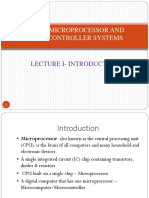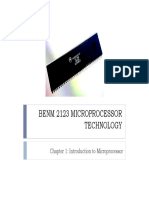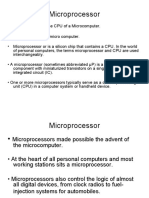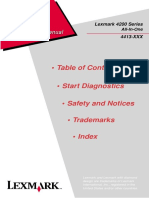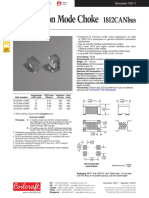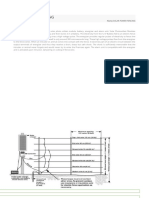What is a computer?
Important terminologies
MEMORY
One of the important feature
Binary digits : 0’s and 1’s
Bit: 0 or 1
Nibble: 4-Bits or half a byte – ex: 0101
Byte: 8-Bit or Byte – ex: 1010 0101
Word : 16-bits – ex: 1111 0000 1010 0101
Kilo Byte: 210 = 1024 bytes, Mega : 220, Giga : 230, Tera : 240
Ex: 16 Megabyte = 16 x 220 = 24 x 220 =224 Bytes
Memory Types: RAM & ROM
RAM or Volatile Memory : Temporary storage
ROM or Non-volatile Memory : Permanent storage
Module - 1 4
IMPORTANT TERMINOLOGY
Input and outputs
I/O devices used to provide a communication with CPU via
keyboard, video monitor etc.,
Buses
CPU is connected through stripes of wires called Buses
Address bus: To identify the device connected to CPU. Total
number of memory location addressable by a CPU is 2x, where x
is the number of bits.
Data Bus: To carry info. in and out of CPU, 8-bit to 64-bit
Control bus: To provide the read or write signal to CPU
Module - 1 5
7
What is a microprocessor?
It is a central processing unit (CPU) on a single
integrated circuit (IC) chip containing millions
of very small components including transistors,
resistors that work together.
INTRODUCTION TO MICROPROCESSOR
Microprocessor – Block Diagram
Module - 1 Microcontroller and Its Applications 20
INTRODUCTION TO MICROPROCESSOR
Microprocessor is a CPU on a single chip.
Microprocessor has several support devices like ROM, Read
write memory, timer, serial interface, I/O ports, etc.
All these support devices are interfaced to the
microprocessor through a system bus.
So finally we can conclude that all support devices in a
microprocessor are connected externally.
Module - 1 21
INTRODUCTION TO MICROPROCESSOR
Module - 1 9
Central Processing
Central Processing Unit Unit
Fetch, decode and executes the instruction stored in memory
CPU must equipped with necessary resource
Important resources of CPU:
Registers – to store the information temporarily
ALU – to carryout Arithmetic and Logical operation
Program Counter – to point the next instruction to be executed
Instruction decoder – to interpret the instruction fetched into
the CPU
Module - 1 3
IMPORTANT TERMINOLOGY
Steps to execute an instruction
1. Fetch Instruction from Memory
2. Decode Instruction and Fetch Operands
3. Perform ALU Operations
4. Store ALU result to register file
5. Memory Access (for load/store)
6. Update Program counter
Module - 1 6
INTRODUCTION TO MICROPROCESSOR
How does it look like?
Module - 1 10
INTRODUCTION TO MICROPROCESSOR
But inside?
Module - 1 11
INTRODUCTION TO MICROPROCESSOR
What was the first microprocessor?
Module - 1 13
History behind first microprocessor
1969: The assignment
Nippon Calculating Machine Corporation approached Intel to design 12
custom chips for its new Busicom 141-PF* printing calculator.
The Intel solution
lntel designed a set of four chips known as the MCS-4. It included
CPU(4004), Shift registers(4003), RAM(4002), ROM(4001)
1971: Era of integrated electronics
Intel purchased the rights from Nippon Calculating Machine
Corporation and launched the Intel® 4004 processor and its chipset
with an advertisement in the November 15, 1971
Module - 1 14
INTRODUCTION TO MICROPROCESSOR
History behind first microprocessor
Module - 1 15
INTRODUCTION TO MICROPROCESSOR
First Microprocessor 4004 - Inventors
Federico Faggin Marcian "Ted" Hoff Stanley Mazor Masatoshi Shima
Module - 1 16
Evolution of Intel processors
32 bit data-32 bit up(pentium pro, pentium II,Pentium III Dual core);64 bit data- 64 bit up(INTEL core 2, Intel core i3,Intel
core i5, Intel core i7)- with 11 generations
Module - 1 17
INTRODUCTION TO MICROPROCESSOR
Microprocessor applications
• Calculators
• Accounting system
• Games machine
• Complex Industrial Controllers
• Traffic light Control
• Data acquisition systems
• Multi user, multi-function environments
• Military applications
• Communication systems
Module - 1 22
INTRODUCTION TO MICROPROCESSOR
Microprocessor Based Temperature Monitoring System
Module - 1 23
INTRODUCTION TO MICROCONTROLLER
What is microcontrollers?
A microcontroller is a compact integrated
circuit designed to govern a specific
operation in an embedded system.
A typical microcontroller includes a
processor, memory and input/output (I/O)
peripherals on a single chip.
Module - 1 24
INTRODUCTION TO MICROCONTROLLER
Used in embedded applications, like remote
control of AC, TV, refrigerators
General purpose processor,
Laptop
Desk top
Interface memory and IO devices externally
Module - 1 25
INTRODUCTION TO MICROCONTROLLER
How does it look like?
Module - 1 26
INTRODUCTION TO MICROCONTROLLER
But inside?
Module - 1 Microcontroller and Its Applications 27
INTRODUCTION TO MICROCONTROLLER
History of first microcontroller
Gary Boone - Inventor of the
Microcontroller
Module - 1 28
INTRODUCTION TO MICROCONTROLLER
MICROCONTROLLER BLOCK DIAGRAM
Module - 1 29
INTRODUCTION TO MICROCONTROLLER
List of microcontrollers?
webpage
Module - 1 30
INTRODUCTION TO MICROCONTROLLER
Microcontroller can be easily interfaced to external
peripheral devices like ADC, DAC, serial ports, Bluetooth,
Wi-Fi, etc.
Examples of the microcontrollers are microchip’s PIC, Intel’s
80196, The 8051, Motorola’s 68HCxx.
Microcontrollers is mainly designed to control
specific electronic applications.
Microcontrollers are normally found in toys, office machines,
automobiles, home appliances, etc.
Module - 1 31
INTRODUCTION TO MICROCONTROLLER
Applications of microcontrollers
• Automobile
• Aeronautics
• Rail Transport
• Mobile communications
• Industrial processing
• Remote sensing , Radio and Networking
• Robotics
• Consumer electronics , music players
• Security (e-commerce, smart cards)
• Medical electronics (hospital equipment, and mobile monitoring) and
• Defense application
Module - 1 32
INTRODUCTION TO MICROCONTROLLER
Microcontroller Based Temperature Monitoring System
Module - 1 33
MICROPROCESSOR vs MICROCONTROLLER
Module - 1 34
MICROPROCESSOR vs MICROCONTROLLER
Microprocessor Micro controller
Contains only CPU in a single chip In a single chip has CPU, memory, IO Ports, Timers, Serial ports etc
We externally interface Memory, IO Ports, Timer On chip Memory, IO Ports,
Flexibility in design-designer can decide on the amount of ROM, No flexibility in design
RAM and I/O ports.
Von Neumann Architecture Harvard Architecture
Can do multitasking Weak in multi tasking
General purpose Application Specific Purpose(Embedded System)
Designed for high speed operations and has high cost Low speed operations and low cost
Hardware can be interfaced externally based on requirements Can handle less hardware externally
High power consumption Battery operated – Low power applications
AMD, Intel 8085,8086, i3, core i5, core i7, core i9 8051, AVR, PIC, ARM
Processing Power- High Low
Design Time- More Less
32
ARCHITECTURE
Von Neumann Architecture Harvard Architecture
Module - 1 36
Comparison of i3, i5 and i7 processor



